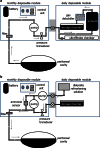Portable and wearable dialysis devices for the treatment of patients with end-stage kidney failure: Wishful thinking or just over the horizon?
- PMID: 25330876
- PMCID: PMC4623087
- DOI: 10.1007/s00467-014-2968-3
Portable and wearable dialysis devices for the treatment of patients with end-stage kidney failure: Wishful thinking or just over the horizon?
Abstract
Dialysis is a life-sustaining treatment for patients with end-stage kidney disease. In a different context, for many patients this treatment is the focal point around which their life revolves, not only due to the time spent travelling to and from treatment sessions and the time dedicated to the dialysis treatment itself, but also due to the accompanying dietary and fluid restrictions and medication burden. Wearable and portable dialysis devices could potentially improve patient quality of life by allowing patients to continue with their daily activities of life while undergoing dialysis, as well as by loosening-or removing entirely-dietary and fluid restrictions and reducing pill burden. Advances in nanotechnology manufacturing coupled with advances in electronics and miniaturisation have allowed a new generation of wearable and portable dialysis devices to be developed which are now undergoing large animal and patient clinical trials. We are therefore potentially at a new dawn in the treatment of dialysis patients with the first generation of wearable and portable dialysis devices, which may well revolutionise the treatment and quality of life for patients with end-stage kidney disease.
Keywords: Haemodialysis; Haemofiltration; Peritoneal dialysis; Portable; Wearable.
Figures





Similar articles
-
[The wearable artificial kidney: what is the current state of play?].Ned Tijdschr Geneeskd. 2019 Jul 4;163:D3728. Ned Tijdschr Geneeskd. 2019. PMID: 31283124 Dutch.
-
[The wearable artificial kidney: a promise for the future?].Ned Tijdschr Geneeskd. 2013;157(52):A6965. Ned Tijdschr Geneeskd. 2013. PMID: 24382046 Dutch.
-
Innovations in Wearable and Implantable Artificial Kidneys.Am J Kidney Dis. 2018 Nov;72(5):745-751. doi: 10.1053/j.ajkd.2018.06.005. Epub 2018 Aug 23. Am J Kidney Dis. 2018. PMID: 30146422 Review.
-
Achieving more frequent and longer dialysis for the majority: wearable dialysis and implantable artificial kidney devices.Kidney Int. 2013 Aug;84(2):256-64. doi: 10.1038/ki.2012.466. Epub 2013 Feb 13. Kidney Int. 2013. PMID: 23407434 Review.
-
Portable and wearable dialysis: where are we now?Hemodial Int. 2010 Oct;14 Suppl 1:S22-6. doi: 10.1111/j.1542-4758.2010.00486.x. Hemodial Int. 2010. PMID: 21040415 Review.
Cited by
-
Wearable artificial kidney and wearable ultrafiltration device vascular access-future directions.Clin Kidney J. 2018 Sep 19;12(2):300-307. doi: 10.1093/ckj/sfy086. eCollection 2019 Apr. Clin Kidney J. 2018. PMID: 30976412 Free PMC article.
-
Effect of Membrane Permeance and System Parameters on the Removal of Protein-Bound Uremic Toxins in Hemodialysis.Ann Biomed Eng. 2024 Mar;52(3):526-541. doi: 10.1007/s10439-023-03397-6. Epub 2023 Nov 22. Ann Biomed Eng. 2024. PMID: 37993752 Free PMC article.
-
Recent advancements in patented technologies for the diagnosis and treatment of chronic kidney disease.Int Urol Nephrol. 2025 Sep;57(9):3045-3063. doi: 10.1007/s11255-025-04501-6. Epub 2025 Apr 11. Int Urol Nephrol. 2025. PMID: 40214918
-
Wearables in Nephrology: Fanciful Gadgetry or Prêt-à-Porter?Sensors (Basel). 2023 Jan 26;23(3):1361. doi: 10.3390/s23031361. Sensors (Basel). 2023. PMID: 36772401 Free PMC article. Review.
-
Advances in Human-Centered Care to Address Contemporary Unmet Needs in Chronic Dialysis.Int J Nephrol Renovasc Dis. 2024 Mar 20;17:91-104. doi: 10.2147/IJNRD.S387598. eCollection 2024. Int J Nephrol Renovasc Dis. 2024. PMID: 38525412 Free PMC article. Review.
References
-
- Davenport A. Membrane designs and composition for hemodialysis, hemofiltration and hemodialfiltration: past, present and future. Minerva Urol Nefrol. 2010;62(1):29–40. - PubMed
-
- Jacobsen SC, Stephen RL, Bulloch EC, Luntz RD, Kolf WJ. A wearable artificial kidney: functional description of hardware and clinical results. Proc Clin Dial Transplant Forum. 1975;5:65–71. - PubMed
-
- Stephens RL, Jacobsen SC, Atkin-Thor E, Kolf WJ. A portable wearable artificial kidney (WAK) initial evaluation. Proc Eur Dial Transplant Assoc. 1976;2:511–518. - PubMed
Publication types
MeSH terms
LinkOut - more resources
Full Text Sources
Other Literature Sources
Medical

